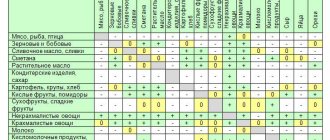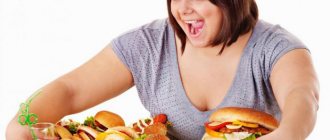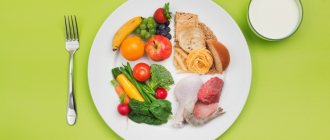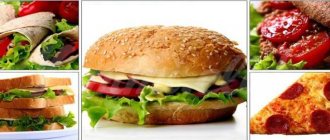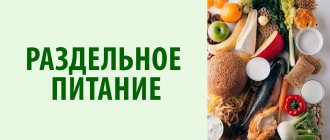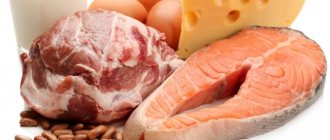History of the concept of product compatibility
Even ancient people knew what separate nutrition was. The ancient Roman physician Celsus mentioned incompatible foods in his writings: he strongly recommended that patients track food combinations in their daily diet. And the Persian healer Avicenna at the beginning of the first millennium BC in his works touches on the topic of the harm of simultaneous consumption of various types of food products. The well-known academician Pavlov conducted research on the enzymatic function of the stomach and concluded that when different types of foods are digested, its chemical composition changes. Nowadays, separate meals are very popular among those who monitor their health or want to lose weight.
How does the body digest food?
Each product is digested by the body at a certain speed. For example, an apple eaten on an empty stomach passes through the esophagus and stomach and enters the intestines within 20 minutes, while meat takes longer to digest. If you eat grapefruit or any other fruit after a heavy lunch, its absorption will be inhibited by the previously consumed food, as a result of which it begins to rot in the intestines.
The digestive process involves not only the participation of gastric juice. Stomach and intestinal bacteria, pancreas, gallbladder and saliva are also involved. Incorrect operation of at least one of the links in this chain affects the outcome of the process.
White bread with jam
A traditional dessert in a hurry, when there is not a single cake in the refrigerator, may also not be as good as many thought. Fast carbohydrates, which make up both bread and jam, increase blood sugar levels most intensely of all foods. And if you combine two sources of fast carbohydrates, this process takes on the scale of a catastrophe. The body has to release shock doses of insulin from the pancreas and work twice as hard as if you took the same amount of carbohydrates, but they would be of a homogeneous composition. In the long term, such stress can greatly affect the health of the pancreas and create insulin resistance, i.e. diabetes.
- 222
More details - 168
More details
- 594
More details
- 182
More details
Why are some products incompatible?
The process of assimilation of nutrients of each type of food requires the presence of certain enzymes. For example, protein food is digested in an acidic environment, and carbohydrate food is digested in an alkaline environment. When they interact, a neutralization reaction occurs, as a result of which the body requires several times more time and energy to digest incompatible products. The consequences of such poor nutrition are a feeling of heaviness in the stomach and decreased performance throughout the day.
Following the basics of separate nutrition helps to heal and prevent many diseases of the gastrointestinal tract. This is because incompatible food products put additional stress on the digestive system, thereby reducing the amount of absorbed vitamins and microelements.
Fruits with any other food
If you decide to eat fruits, then you should not combine them with other foods, this can negatively affect your health and cause digestive problems. Remember that fruits should always be eaten separately without additives.
Digestion of fruits in the stomach occurs very quickly. They do not cause heaviness, saturate the body with vitamins, useful components and satisfy hunger well. But this is only possible if they are used separately.
If they are eaten with food or after food, this can lead to a long delay. As a result, their fermentation will occur, namely fermentation. This can cause serious damage to the lining and walls of the stomach, which can ultimately lead to ulcers.

Why is it important to choose the right food combinations?
The task of the gastrointestinal tract is to digest various types of food, both plant and animal origin. The main element of the digestive system is the intestinal microflora. It is this that determines the outcome and quality of the entire process - how quickly the incoming substances are converted into nutritional compounds or rotting products.
The intestinal microflora has a large qualitative and quantitative composition. Moreover, some species are dominant, while others are suppressed. The species composition is determined by the nature of the food consumed and the rate of metabolism. If the products included in the daily diet are natural and correctly combined, the microflora becomes stable.
If a person consumes incompatible foods or overeats, the work of first the stomach and then the intestines is disrupted. Food that stagnates in the intestines begins to be consumed by putrefactive bacteria. They secrete poisons and toxins, which first enter the liver, then the kidneys, and then spread throughout the body. This mechanism is the cause of many diseases.
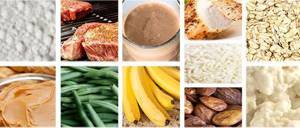
Shelton's Principle
Herbert Shelton is an American nutritionist. His great merit lies in the fact that he collected and analyzed medical experience regarding the basics of separate nutrition. It is on its principles that most health diets are now based.
Shelton also developed the so-called “simple nutrition” principle. Its meaning is that the maximum benefit from the foods consumed can be obtained through the uniformity of the diet at one meal.
According to Shelton, for a greater healing effect it is necessary to use fasting. However, this aspect caused a storm of emotions and indignation among his colleagues. The application of these principles has made it possible to cure many patients from diseases such as neurosis, diabetes mellitus of both types, and bronchial asthma. However, not all of Shelton’s patients were cured, which is why the doctor went to jail.
Scientists have compiled compatible and incompatible human food products into a table that we are used to seeing now. It is recommended to combine no more than three products in one meal. Ideally, there should be one product per dose.
Dangerous combinations: what foods should not be eaten together?
To be healthy and feel great, it is not enough to know healthy food recipes - you need to be able to correctly combine foods with each other. Find out which “duets” can harm your health! Our experts reveal the secrets of proper nutrition.
Main course and fruit
Who among us was not told by our parents as a child - first porridge, then dessert. We obediently ate the oatmeal and only then received the tasty and aromatic fruits. Meanwhile, combining the main dish and fruits in one meal is undesirable.
The thing is that fruits, due to their high fiber content, are quickly digested and enter the intestines.
But if they enter the body along with cereals or meat products, they get stuck in the gastrointestinal tract for a long time. As a result, the fermentation process starts and a “storm in the stomach” occurs.
For fruits to benefit you, you need to eat them 40-50 minutes before your main meal.
Fresh vegetables and low-fat sauce
The warm season is the traditional time for picnics and outdoor recreation - in a garden plot, in the forest or on the seashore. An outdoor feast is rarely complete without light salads made from fresh vegetables. In order to lose weight, some doctors recommend seasoning summer dishes with low-fat sauce. But recent research by scientists shows that doing so is undesirable.
By adding low-fat sauce to the salad, you thereby disrupt the process of absorption of nutrients by the body. In order for greens and vegetables to bring maximum benefits to your body, you need to eat them raw or season them with lemon juice or olive oil.
Yogurt and fruit
The favorite delicacy of many children and adults is not as harmless as we think. Doctors came to the conclusion that such a duet could cause unpleasant consequences.
It is not advisable to combine dairy products with any other products. And during the treatment of colds, it is better to avoid them altogether.
Few people know that fermented milk promotes the formation of mucus, so when it is taken, the symptomatic picture of acute respiratory viral infections and acute respiratory infections intensifies.
If you like sweet yoghurts, try to buy those that come without fruit additives, but with the obligatory presence of healthy microflora.
Animal protein and starch
When choosing a side dish for meat products, we often give preference to cereals and potatoes. Although nutritionists do not recommend combining them together. Digestive enzymes in these food groups conflict with each other, which leads to a feeling of heaviness after eating, discomfort and flatulence.
The most starch is found in rice, oats, buckwheat, corn, wheat and potatoes. Experts include broccoli, Brussels sprouts, cauliflower, celery, green peas, leeks and onions, radish, spinach, zucchini, and eggplant as non-starchy foods. Keep this in mind when choosing a side dish for your chops.
Cereals, muesli and milk
At first glance, it seems that these products are simply made for each other; they have long been considered a “classic” of a healthy breakfast and are recommended for everyone, young and old. But you need to know that this tandem can contribute to a deterioration in well-being.
The reason for this is the high content of simple carbohydrates in the listed products. When such a “shock” portion enters the body, a sharp jump in blood sugar occurs, which gives a boost of energy, but after very little time a sharp decrease occurs.
And here a feeling of fatigue sets in, there is a loss of strength, you want to eat something high-calorie, fatty, harmful - that is, to have a solid meal.
The way out of the situation is to combine milk with whole grains, then there will be no sharp fluctuations in blood sugar levels and a heavy load on the pancreas.
Sweet pastries and fruit juices
This combination of products can be called not so much harmful as useless from a nutritional point of view. This duet is characterized by a high sugar content and a complete lack of “benefits” - fiber and protein. If you like to start your day with a sweet pastry and a glass of freshly squeezed juice, know that by lunchtime you won't have any energy left to get things done.
Therefore, choose healthier breakfast combinations, and when planning a snack, give preference to at least baked goods made with whole grains.
Milk and tea
High-quality teas are rich in antioxidants. Just a record amount of them is contained in green tea. As you know, these beneficial substances reduce inflammatory processes in the body, prevent the occurrence of many known diseases, resist the damaging effects of free radicals, and slow down aging.
If you add even a small amount of milk, including soy milk, to black, white or green tea, the amount of antioxidants will decrease. German scientists claim that casein, a protein found in milk, destroys catechin, which is present in all types of tea and is a powerful antioxidant. Therefore, it is not advisable to use them together.
Alcohol and caffeine
At a festive feast you exceeded the permissible alcohol limit and now you need to “cheer up”? Friends immediately advise drinking strong coffee or black tea. Since few people know that such a tandem can lead to unpleasant consequences. In the first minutes after tasting a caffeinated drink, the signs of intoxication will indeed become less pronounced, but this will not last long.
Researchers at Wake Forest University have shown that people who drink straight alcohol are less likely to get into trouble than those who mix it with caffeine.
Source: https://ya-krasotka.com/973655953648389054/opasnye-sochetaniya-kakie-produkty-nelzya-est-vmeste/
Hay's theory
Howard Hay also conducted research in the field of separate nutrition in dietetics. He took Shelton's principles as a basis, but eventually developed his own theory.
According to Hay, food products are divided into three classes:
- Protein.
- Carbohydrates.
- Neutral.
The nutritionist called for eliminating some types of food altogether. He was also categorically against the presence of refined food in the diet.
What products are incompatible according to this theory? Hay was of the opinion that a person consumes a large number of foods that “over-acidify” the body. This causes a variety of diseases - from skin rashes to migraines and ulcers. Accordingly, you should eat foods that cause an alkaline reaction, namely natural vegetables and fruits, fermented milk products. There should be four times more “alkaline” food than “sour” food. The latter included meat, fish, eggs, all citrus fruits, coffee, sweets and alcohol.

Separate power theory
Diet theory is an attempt to explain how food and lifestyle influence human health. Its authors are American naturopaths of the early 20th century. They are often called doctors in Russian literature, but they are, rather, practitioners, supporters of natural healing methods, and adherents of alternative medicine. These people were treated with healthy food, work in the fresh air and gymnastics. Modern science of food hygiene offers just such an arsenal for those who want to stay healthy.
It was within the framework of naturopathy that the doctrine of product incompatibility was born. Its main postulates are:
- when we eat mixed food, the body simply has no chance to absorb the food. He cannot get glucose and proteins from potatoes with meat, since he digests mainly meat. And the potatoes will “rot” in the gastrointestinal tract, since there are simply not enough digestive enzymes for them;
- If we carry within ourselves a source of infection, rot, and decomposition, we cannot even dream of any good health. Of course, it will all start with a gastrointestinal disease, continue with metabolic diseases, and end with the collapse of the immune system, and a bunch of even more diseases;
- Continuing to eat this way all our lives, and even topping it all with “food poisons,” that is, coffee and tea, we get triple health problems. In general, by the age of 30 we will have a bunch of chronic diseases, and then a short and unhappy life;
- In addition, we do not work physically, which means that our body literally “does not want” to digest the meager rations that we give it. The conclusion is quite simple - you need to change everything in your diet and life.
Naturopaths believed that obesity is a protective reaction to the large number of food toxins and waste products that we get from regular food. The body, as it were, “packs” poisons into fat cells so that we can function normally and remain healthy.
In fact, this theory is not confirmed in practice.
Sweet fruits
These include dried fruits of all types, bananas, dates, raisins, dried melon.
Fruits are digested relatively quickly, with sour fruits quickly passing the stage of digestion in the stomach, and sweet ones - slowly. Therefore, it is best to eat them separately as an independent dish or an hour and a half before a meal, and at least three hours should pass from the last meal. They should not be used as a component of desserts. This rule also applies to fruit juices. Products of this type are completely compatible with any fruit, cereals, and fermented milk foods.
Potatoes and tomatoes
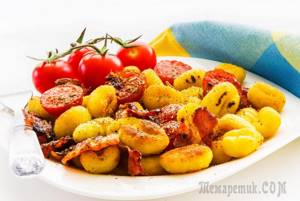
Along with potatoes, it is unacceptable to eat other starch-containing products with tomatoes. Tomatoes with starch are long-time irreconcilable enemies. Heaviness in the stomach and indigestion are just the beginning. If you regularly test your body's strength with such gastronomic duets, you can get gastritis and even peptic ulcers.
It is, of course, difficult to keep track of all undesirable combinations, and it is not always possible. Therefore, it is important to be able to provide yourself with quick help in such cases. If a “party” has started in your stomach, sorbents will help. This is regular activated carbon, Polysorb or Enterosgel. They will also relieve the symptoms of intoxication, if it was not caused by more serious reasons. Still, it’s better to try to exclude enemy foods completely from one meal. At best, healthy food turns into empty, meaningless edible mass, at worst into self-prepared poison.
Semi-sweet (semi-sour) fruits
These are wild berries, mangoes, apples, pears, cherries, watermelon, grapes, peaches, plums, apricots, tomatoes.
Products of this type go well with each other, as well as with all fruits, herbs, dairy products, high-protein foods (nuts, cheese, fatty cottage cheese). Wild berries can be combined with milk. Incompatible foods include meat, fish, eggs, grains and legumes. This is explained by the difference in the rate of absorption. It is not recommended to eat semi-sweet fruits with starchy foods.
It is important to note that melons, namely melons and watermelons, cannot be combined with anything. After eating them, other food gets stuck in the stomach and then begins to rot, which inevitably leads to bloating.

Yogurt with fruits
Ayurveda and the theory of food compatibility do not recommend mixing fruits and dairy products. This combination has a bad effect on digestion, changes intestinal flora and even causes allergies. But if you can't resist yogurt with fruit, there is a solution. First, take natural yogurt at room temperature. Second, mix it with honey, cinnamon and raisins instead of fresh berries or fruit.
Did you like our article? Then read about foods that can easily deprive you of sleep.
Protein products
This includes meat, fish, poultry, eggs, cheeses, cottage cheese, dairy products, legumes, nuts, and mushrooms. Protein foods are best combined with greens and all types of vegetables, as they speed up the digestive process and help remove toxins from food. You can also eat fats with protein foods, but since they slow down digestion, you should add greens to such dishes. Protein foods should not be combined with starchy foods, as well as with fruits and sugars. However, with fruits, as an exception, it is permissible to eat cottage cheese, cheese, fermented milk products, and nuts.

Milk should be separately distinguished from products of this type. Milk is a food, not a drink. It needs to be coagulated by stomach enzymes before entering the intestines. If milk enters the stomach along with other food, it envelops the mucous membrane and prevents it from working as usual. Products incompatible with milk include almost all types of food. You can combine fruits with it, but this combination is not suitable for all people. Nutritionists advise drinking milk always warm.
After meal
How many “benefits” the body receives from what it eats depends on what, how much and, most importantly, when it is drunk after eating. Nutritionists advise: after finishing what’s on your plate, pause for half an hour - the liquid dilutes the gastric juice, impairing digestion and, accordingly, the absorption of food.
If you had porridge for breakfast, it is better to drink green tea or coffee; and if omelet or scrambled eggs - orange or apple juice. The finale of the meal can be a compote of fresh or dried fruits and berries, which also provides an additional portion of potassium.
But table drinking water is best for “washing down” lunch and dinner. Just not from the refrigerator - the low temperature of the liquid prevents the breakdown of proteins, stimulates peristalsis, pushing semi-digested food from the stomach into the duodenum. You should not wash down your food with sweet soda, this sharply reduces the absorption of proteins.
Article on the topic
Pairing rules: what goes with white, rosé and red wines
Greenery
This type of food includes lettuce, nettle, leek, sorrel, cilantro, parsley, dill and other green plants eaten. Greens go well with any type of food, with the exception of milk. Doctors recommend including one bunch of any kind of greens in your diet every day. It brings particular benefits in combination with starchy and protein foods, since it accelerates its digestion, neutralizes poisons, improves peristalsis of the intestinal muscles, and contains vitamins.
At the same time you can and even need to eat the following
- Broccoli and roasted meat . Meat produces toxins that increase the likelihood of developing cancer. Broccoli provides neutralization of carcinogens.
- Marinade and fried fish . Everything here is similar to the products described above, only the marinade acts as a carcinogen neutralizer.
- Carrots and meat . Vitamin A, which is present in carrots, is absorbed only in combination with protein elements. Beef and chicken contain a lot of protein. Potatoes, sweet peppers, liver. The liver contains a lot of iron, which is absorbed thanks to vitamin C contained in potatoes and peppers.
- Citruses and apples . The iron found in apples is absorbed 5 times better if you immediately eat citrus fruit containing vitamin C after the apple.
- Fish and wine . Fish saturates the body with omega-3 acids, which are perfectly absorbed together with wine.
- Figs and milk . Magnesium-rich figs improve the absorption of calcium, which is present in milk.
If food is incompatible with vitamins, a reverse reaction begins. Nutrients are poorly absorbed, which provokes hypovitaminosis and vitamin deficiency.
How soon can you eat incompatible foods? Nutritionists say that 2 hours should pass between eating incompatible foods. However, certain fruits can be eaten as early as 20 minutes after eating an incompatible product.
Next, you can find out what foods are incompatible with alcoholic beverages, dairy products, and medications.
Fats
This group of products includes butter, ghee, vegetable oil, lard, cream, sour cream and other fats of animal origin. This often includes fatty meat (pork), fish and nuts.
The main distinguishing feature of fats is that they slow down the process of secretion of gastric juice, especially when consumed at the beginning of a meal. They also have a softening effect if products that are incompatible with each other enter the body. For example, pork and potatoes are better digestible if sour cream is added to it. Fats go well with herbs, all types of vegetables, and foods rich in starch. It is allowed to consume fats with any type of fruit, for example, wild berries with sour cream.
The most incompatible foods with fats are sugars. Such combinations should be avoided. It is in this case that the “inhibiting” effect of fats manifests itself most clearly. It is also extremely undesirable to mix vegetable and animal fats in food, and it is best to replace butter with ghee.
What products don't go together?
According to supporters of the theory of separate nutrition, we must part with most traditional dishes. After all, cereals and meat do not go together, the same can be said about cereals and fish, pasta and potatoes with meat and fish, and all of the above with milk and cottage cheese. It turns out that we cannot have breakfast with milk porridge, lunch with soup with meat, and dinner with meat and potatoes, but must eat porridge with water, soup with meat and light vegetables, and one thing - either potatoes, or meat or fish for dinner .
The “bases” of our favorite desserts don’t go together either. Simple carbohydrates should not be found in dishes with fats, otherwise they will contribute to the accumulation of fat in us. Thus, it turns out that the only sweets you can eat are marshmallows and marshmallows, and everything else is not recommended. In addition, proteins are not friendly with saturated animal fats, that is, we should never eat pork, fatty lamb and beef.
You cannot eat starches (porridge and potatoes with pasta) with acid, that is, with citrus fruits or pickled vegetables, and you cannot do the same with protein dishes. Oranges, lemons and grapefruits should be consumed separately.
Melon, as well as caffeine and alcohol, cannot be combined with any products. And if the fruit is recommended to simply be eaten separately, then alcohol with caffeine is advised to be forgotten forever.
Sahara
These include sugar (both white and cane), fructose, syrups, jams, honey.
When combined with protein or starchy foods, sugars provoke fermentation, which significantly reduces the benefits of the foods consumed. Sugars should be consumed separately, or better yet, avoid them altogether. And if you decide to drink tea with sugar and sweets, then it is better to do this before a meal, but in no case after it.
However, there is an exception to these rules - honey. In small quantities, it goes well with all types of food, as it slows down rotting and fermentation. But you can’t use it every day.
Criticism
Herbert Shelton had no medical training. He graduated from Bernard Macfadden 's College of Physcultopathy
), school of naturopathy and school of chiropractic;
studied in sanatoriums that practice fasting. Shelton was repeatedly arrested and paid fines for practicing medicine and giving medical lectures without a license.
Some of the patients who followed his dietary advice died. So, in 1963, G. Shelton prescribed seven-year-old R. Sullins a strict diet of water and juices. Her father, D. Sullins, is a member of the American Natural Hygiene
, headed by Shelton, strictly followed his instructions and constantly informed Shelton about his daughter’s condition.
After 41 days of illness, the girl died due to exhaustion and pneumonia. In 1981, W. Carlton spent 30 days at Shelton 's Health School
on a diet of distilled water, lost 23 kg of weight and died due to pneumonia caused by weakening of the body. This was the sixth patient death at the school in the five years before it closed in 1981.
Surgeon William Howard Hay, in addition to promoting his “Hay Diet,” is known for actively opposing smallpox vaccination and also recommending that patients with type 1 diabetes stop insulin therapy, for which he was sharply criticized in the Journal of the American Medical Association.
Incompatible foods for weight loss
If you strictly follow the basics of separate nutrition, you can not only improve your body’s health, but also lose weight, because most modern diets rely on them. Although such a nutritional system hardly corresponds to the definition of “diet”, since it only mentions a list of products that are most compatible with each other.
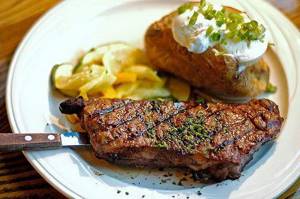
So, first you need to study incompatible foods when losing weight. This group includes the following combinations:
- Protein food with flour products.
- Combining proteins of plant and animal origin in one go.
- Combining flour products in one meal.
- Protein products with sugars.
- Flour products with fruit.
- Flour products with milk.
- Protein food with milk.
The so-called “90” nutrition system has become especially popular among diets. It consists in the fact that for 90 days it is necessary to adhere to a four-day cyclical diet, that is:
- The first day is protein.
- The second day is starchy.
- The third day is a carbohydrate day (you can eat sweets).
- The fourth day is a vitamin day (vegetables, fruits).
This diet is very easy to follow, because the body will be saturated with all the necessary substances, so there will be no breakdowns.
You should also adhere to the following recommendations to achieve better results:
- Refined foods should be excluded (wheat flour, white sugar, margarines).
- An interval of 3-4 hours should be maintained between main meals.
- Sour fruits and protein foods should not be eaten with carbohydrate foods at the same time.
Incompatibility and compatibility of products, separate nutrition according to Shelton (Table)
The essence of food compatibility is that ideally a person should eat 1 food item at a time. This way, all nutrients will be absorbed to the maximum extent possible.
Compatibility and incompatibility of products, separate nutrition according to Shelton
According to Shelton's separate nutrition method, naturopaths classified food products and divided them into groups:
| Squirrels | meat, fish, eggs, cheese, cottage cheese, nuts, mushrooms, beans, legumes, dry peas, eggplant, milk, sunflower seeds |
| Carbohydrates | potatoes, cereals, dried beans, pumpkin, zucchini, beets, carrots, cauliflower, sweet fruits - raisins, dried apricots, figs, persimmons, dates, dried pears and sweet apples |
| Fats | all types of vegetable oils, nuts, lard, fatty meat, sour cream, cream |
| Green vegetables | lettuce, celery, onion, spinach, sorrel, dill, parsley, cucumbers, cabbage, garlic, rhubarb, sweet peppers of all colors, all kinds are rare, etc. |
| Fruits | sour (including tomatoes), semi-sweet |
Green vegetables are compatible with the previous three groups. All of these groups, with the exception of green vegetables, are incompatible with each other. And in the groups themselves you cannot mix products. As you can see, low-fat lettuce is a desirable ingredient in all dishes. Bread and butter also go together.
Change your diet gradually, taking into account food compatibility and Shelton's principles of food division.
Using this classification, you can choose your daily diet so that the foods are not only compatible, but also match the proportion of acidic and alkaline foods, which should be about half.
As you gradually change your diet, increase your consumption of raw foods, as they provide the energy the body needs and cannot get from another source.
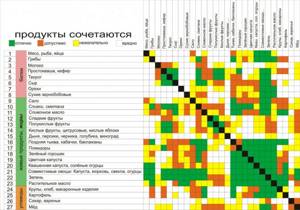
Table of compatibility and incompatibility of products according to Shelton
| Food | Compatible with products: | Incompatible with products: |
| Lean meat, lean fish, lean poultry | • Green vegetables; • Vegetables that do not contain starch | • Pulses; • butter, cream; • sour cream; • vegetable oil; • sugar, condit. products; • bread, cereals, potatoes; • all types of sour fruits, tomatoes; • all types of sweet fruits, dried fruits; • milk; • cottage cheese, fermented milk. products; • cheese, feta cheese; • eggs; • nuts |
| Pulses | • Sour cream, grows. oil; • Vegetables that do not contain starch (except for potatoes); • vegetables that are green and do not contain starch | • lean meat and fish, lean poultry; • sugar, condit. products; • all types of sour fruits, tomatoes; • all types of sweet fruits, dried fruits; • milk; • cottage cheese, fermented milk. products; • cheese, feta cheese; • eggs; |
| Drain oil, cream | • Bread, cereals, potatoes; • sour fruits, tomatoes; • starchy vegetables; • green and non-starchy vegetables | • lean meat, lean fish, lean poultry; • vegetable oil; • sugar, confectionery; • all types of sweet fruits, dried fruits; • cottage cheese, fermented milk products; • eggs; • nuts |
| Sour cream | • Grain legumes; • bread, cereals, potatoes; • sour fruits, tomatoes; • starchy vegetables; • green and non-starchy vegetables; • cottage cheese, • fermented milk products | • lean meat, lean fish, lean poultry; • sugar, confectionery; • milk; • nuts |
| Vegetable oil | • Grain legumes; • bread, cereals, potatoes; • sour fruits, tomatoes; • starchy vegetables; • green vegetables, non-starchy vegetables; • nuts | • lean meat, fish, poultry; • drained oil, cream; • sugar, confectionery; • milk; • cottage cheese, fermented milk products; • cheese, feta cheese; • eggs |
| Sugar, condit. products | • Green vegetables, non-starchy vegetables | • Meat, fish, lean poultry; • grain legumes; • drained oil, cream; • sour cream; • vegetable oil; • bread, cereals, potatoes; • all types of sour fruits, tomatoes; • all types of sweet fruits, dried fruits; • starchy vegetables; • milk; • cottage cheese, fermented milk products; • cheese, feta cheese; • eggs; • nuts |
| Different types of bread, cereals, potatoes | • Butter; • cream; • sour cream; • vegetable oil; • starchy vegetables; • green vegetables, non-starchy vegetables; | • Meat, fish, lean poultry; • sugar, confectionery products; • all types of sour fruits, tomatoes; • all types of sweet fruits, dried fruits; • milk; • cottage cheese, fermented milk products; • eggs |
| All types of sour fruits, tomatoes | • Butter and cream; • sour cream; • vegetable oil; • green vegetables, non-starchy vegetables; • cheese, feta cheese; • nuts; | • Meat, fish, lean poultry; • grain legumes; • sugar, confectionery products; • bread, cereals, potatoes; • milk; • eggs |
| All types of sweet fruits, dried fruits | • Green vegetables, non-starchy vegetables; • cottage cheese, fermented milk products. | • Meat, fish, lean poultry; • grain legumes; • drained oil, cream; • sugar, confectionery products; • bread, cereals, potatoes; • cheese, feta cheese; • eggs |
| Green vegetables, non-starchy vegetables | • Lean meat, lean fish, lean poultry; • grain legumes; • butter and cream; • sour cream; • vegetable oil; • sugars, confectionery products; • sour fruits, tomatoes; • bread, cereals, potatoes; • sweet fruits, dried fruits; • starchy vegetables; • cheese, feta cheese; • cottage cheese, fermented milk products; • eggs; • nuts; | • Milk |
| Starchy vegetables (except potatoes) | • Grain legumes; • butter and cream; • sour cream; • vegetable oil; • bread, cereals, potatoes; • green and non-starchy vegetables; • cottage cheese, • fermented milk products; • cheese, feta cheese; • nuts; | • Sugar, confectionery products |
| Milk | • Meat, fish, lean poultry; • grain legumes; • sour cream; • vegetable oil; • sugar, confectionery products; • bread, cereals, potatoes; • all types of sour fruits, tomatoes; • green vegetables, non-starchy vegetables; • cottage cheese, fermented milk products; • cheese, feta cheese; • eggs; • nuts | |
| Cottage cheese, all types of fermented milk products | • Sour cream; • sweet fruits, dried fruits; • starchy vegetables (except potatoes); • green vegetables, non-starchy vegetables; • cheese, feta cheese; • nuts | • Meat, fish, lean poultry; • grain legumes; • drained oil, cream; • vegetable oil; • sugar, confectionery products; • bread, cereals, potatoes; • milk; • eggs |
| Cheese, feta cheese | • Sour fruits, tomatoes; • starchy vegetables (except potatoes); • green vegetables, non-starchy vegetables; • cottage cheese, fermented milk products. | • Meat, fish, lean poultry; • grain legumes; • vegetable oil; • sugar, confectionery products; • all types of sweet fruits, dried fruits; • milk; • eggs |
| Eggs | Compatible with green and non-starchy vegetables | • Meat, fish, lean poultry; • grain legumes; • drained oil, cream; • vegetable oil • sugar, confectionery products; • bread, cereals, potatoes; • all types of sour fruits, tomatoes; • all types of sweet fruits, dried fruits; • milk; • cottage cheese, fermented milk products; • cheese, feta cheese; • nuts |
| Nuts | • Vegetable oil; • sour fruits, tomatoes; • starchy vegetables (except potatoes); • green and non-starchy vegetables; • cottage cheese, all types of fermented milk products. | • Meat, fish, lean poultry; • drained oil, cream; • sour cream; • sugar, confectionery products; • milk; • eggs |
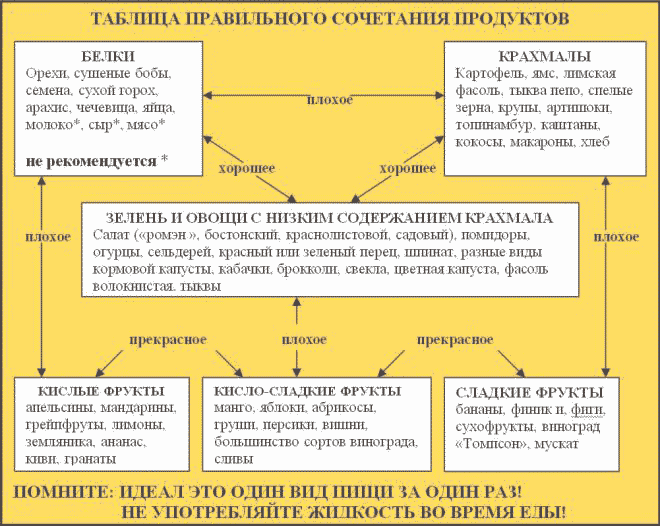
Table of product incompatibility and harm to the body
This table lists products whose combinations in one form or another can lead to negative consequences for the body.
| Incompatible products | Harm to the body, side effects |
| SEAFOOD + TOMATOES | Causes nausea, intestinal upset, and the properties of protein are leveled. |
| CUCUMBERS + TOMATOES, HOT PEPPERS | Destroys vitamin C |
| BEEF + CHESTNUT | Impairs digestion |
| WHITE RADISH + APPLE, MANDARNINE, TOMATO, GRAPES | Causes a sore throat |
| BEEF WITH YOUNG GARLIC | Poison for the whole body! |
| CARROTS + WHITE RADISH | Causes blood cancer |
| LAMB + TEA | Impairs digestion |
| SODA DRINKS + SPICY FOODS | Causes diseases of the gastrointestinal tract (GIT) |
| BEEF + FISH | Poison for the liver and kidneys. They don't fit in any way! |
| ONION + GARLIC | Causes intestinal cramps and impairs digestion. |
| CARROTS + VODKA | Causes severe liver poisoning |
| CORN + BUCKWHEAT | It provokes skin diseases, worsens metabolism, and concentration decreases. |
| PRAWNS + PEPPER, TOMATO | Poison for the whole body! |
| SOY MILK + EGG | The properties of protein are leveled, and the digestibility of products deteriorates. |
| BEER + SAUSAGES or GRILLED SAUSAGES | Causes cancer! |
| RABBIT + CELERY | Causes hair loss and dullness. From the gastrointestinal tract - diarrhea. |
| LIVER + CAULIFLOWER | Poison for the whole body! |
| TEA + EGG, TOFU CHEESE | Impairs digestion. |
| FISH + PICKLES | Poison for the whole body! Causes cancer! |
| MEAT + TEA | It neutralizes the properties of protein and is harmful to the intestines. |
| RABBIT + DUCK | Causes diarrhea, chills, weakness in the body. |
| LAMB WITH GINGER | Causes dry mouth, sore throat, kidney pain. |
| HONEY WITH GARLIC AND ONION | Impairs vision! |
| GREEN BEANS + HONEY | When consuming foods in this combination, vitamin B1 is destroyed. |
| VODKA + PEACH | In any form, from compote to the fruit itself, it causes dizziness, nausea, and arrhythmia. |
| VODKA + TOMATO | In any form, including with tomato juice, it causes kidney stones, pulmonary diseases, oxygen starvation... |
| BANANA + MELONS | Provokes kidney failure and joint diseases. |
| CHICKEN + SESAME, CHAMOMILE TEA | Poison for the whole body! |
| SOY MILK + HONEY | Causes diarrhea, tinnitus. |
| VINEGAR + CARROTS | Makes carrots useless for the body, all vitamins disappear. |
| CHICKEN + CELERY, MUSTARD | Reduces energy activity, this combination is dangerous for the kidneys. It also reduces potency and negatively affects sperm. |
| PORK WITH PEAS | Causes bloating and increased gas formation. |
| CRAB + PEANUTS | Impairs intestinal motility and causes indigestion. |
| RADISH + BLACK MUSHROOMS | Causes skin allergies. |
| MILK + CHOCOLATE | Causes dry hair and impairs digestion. |
| BANANA + POTATOES | This combination is extremely harmful to the skin, blackheads may appear... |
| VODKA + SODA DRINKS | A terrible blow to the stomach, liver and kidneys at the same time! This combination provokes cardiovascular diseases. |
| MONSOLUM GLUTAMATE + EGG | In any combination, a terrible poison for the entire body, leading to death! |
| VODKA + COFFEE | Impairs cerebral circulation. |
| TOFU CHEESE + SPINACH | Digestion worsens, and bloating often occurs. |
| BEER + MEAT SOUP | Very harmful to joints, kidneys and gallbladder. |
| YOUNG GARLIC + VODKA | Provokes gastrointestinal diseases, hemorrhoids, bleeding. |
| BEER + SHELLS | Provokes cancer, kidney stones and gall bladder. |
| VODKA + TEA | Completely incompatible drinks provoke heart and kidney diseases. |
| LAMB + PUMPKIN, WATERMELON | Reduces energy activity, negatively affects sperm and the body’s lymphatic system |
| MILK + POMEGRANATE, GRAPES, ROSE HIP | Causes nausea, dizziness, bloating, and intestinal upset. |
| CUCUMBERS + PEANUTS | This combination is extremely bad for the kidneys. Causes diarrhea. |
| BEER + VODKA | A terrible blow to the liver, kidneys and heart |
Products incompatible with alcohol
It is not recommended to combine alcohol with high-protein foods. The process of protein digestion begins in the stomach due to the action of the enzyme pepsin. When drinking alcohol, pepsin is deposited, resulting in undigested food entering the intestines.
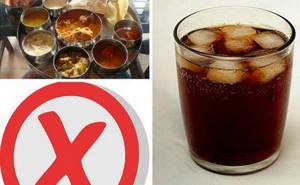
The principles of a separate food system are based not only on postulates about which products are incompatible. It helps you choose the most successful combinations, and many of them will definitely suit everyone’s taste. Separate nutrition helps not only improve the health of the body, but also say goodbye to extra pounds and get rid of food allergies, because the latter is a natural reaction to rotting protein foods. If you decide to adhere to a separate food system, special food compatibility tables will be useful to you. With their help you can easily create a daily menu.
Alcohol and caffeine
The classic situation: you drink a couple of glasses of wine with dinner, you start to feel sleepy, and to cheer yourself up, you drink a cup of coffee. This is a very, very bad idea, and here's why. The burst of energy you get from caffeine masks alcohol intoxication, preventing you from being in control of your condition. The same can be said about cocktails like whiskey and cola or vodka and red bull. In addition, the body receives too contradictory messages from the substances it absorbs. On the one hand, you relax him with alcohol, on the other, you force him to be alert with the help of caffeine.

